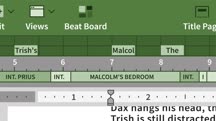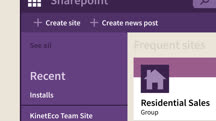Course catalog
Categories
Showing 841-860 of 1,450 items.
Learning Print Production: Photoshop, Illustrator, and InDesign (211341)
If you work in print production—whether you're a designer, a production artist, or a prepress operator dealing with client files—the goal is generally still the same for everyone: use the software without causing problems when the job hits the press. While the software is extremely helpful in layout and designing, sometimes the software doesn’t know best and it’s good to know the pitfalls. In this course, Claudia McCue takes you through layout best practices with Photoshop, Illustrator, InDesign, and Acrobat. Claudia covers features to look out for, best practices, and important topics like text basics, how to import graphics, layout tips, color swatches, and pre-flighting. After this course, you’ll be better prepared to create documents that print successfully.
Learning Procreate (222850)
Learn everything you need to know to get started on mobile painting and drawing using Procreate, a premier digital drawing tool for the iPad. Instructor Karen Larson reviews the tools, techniques, and tips needed to create your own digital art, graphics, and lettering. No previous drawing experience is required—this course is useful for artists of all skill levels. Explore the Procreate interface and discover how to create custom brushes in the Brush Studio. Learn to maximize your creativity and flexibility with layers, experiment with transparency and blend modes, and work with shapes and guides. Karen also explains how to recolor and adjust your artwork with effects, and export it from Procreate for sharing. Plus, get tips on animating illustrations and creating custom calligraphic lettering in the bonus chapter.
Learning Revit 2022 (Imperial and Metric) (222952)
Autodesk Revit is one of the most popular building information modeling (BIM) solutions today. In this course, join Paul F. Aubin as he delves into the basics of Revit 2022, showing architects and engineers who are new to the software how to work with its key features. Learn how to choose a template; set up the basic levels, grids, and dimensions; and start adding walls, doors, and windows to your model. Paul also demonstrates how to create views and documentation that clearly communicate your plans, import files from other CAD programs, and produce detailed construction documents. Plus, learn how to create a high-quality photorealistic rendering from any 3D view using the cloud rendering service in Revit 2022.
Note: This course includes exercise files in both imperial and metric units.
Note: This course includes exercise files in both imperial and metric units.
Learning Rhino 6 for Mac (224771)
Rhino 6 for Mac is here. While it doesn't have the exact same features as its Windows counterpart, Rhino for Mac offers both precise and organic modeling tools, making it a great choice to designers who need to create complex forms and shapes. This course covers the key differences between the Mac and Windows versions, basic interface navigation, and techniques for generating high-quality 3D models for a variety of industries, including manufacturing, architecture, and animation. Author Chris Reilly starts by showing how to create simple geometry from points and curves and progresses to extruding solid objects for 3D printing or CNC milling. He closes with some lessons on applying custom materials and rendering your design. No prior experience with Rhino is required! Simply start watching to get up and running with this powerful 3D modeling software.
Learning SAP Production Planning (215285)
SAP Production Planning (PP) is a very useful data analysis module for companies involved in production or manufacturing of goods. In this course, instructor Justin Valley walks through how to use the SAP Production Planning module for discrete, repetitive, and process manufacturing. Justin shows various ways the production planning module can leverage data inside SAP to help inform business decision-making and to help streamline the production and manufacturing processes for a company. He gives you an overview of the SAP Production Planning module, then goes into master data, the mostly static information that Production Planning and production execution rely upon. Justin explains planning strategies and processes in SAP, then finishes up with a thorough explanation of the production execution step.
Learning Screenwriting with Final Draft 12 (223071)
Writing scripts for the big or small screen is a dream for countless aspiring creatives. As communication has grown increasingly visual—and video technology has become increasingly accessible—the art and craft of screenwriting has found powerful additional uses in everything from politics to marketing to education. Final Draft 12 is a leader in the creation and revision of screenplays of all types, and is the go-to tool for novices and veteran screenwriters alike.
This step-by-step, interactive course gets aspiring screenwriters—or pros who haven’t yet used Final Draft—up to speed quickly. Highlighted are the latest cutting-edge features in version 12 that enable brainstorming, alternate versions of dialog, and more. Your guide, Academy Award-nominated screenwriter Roger S.H. Schulman, also offers insider tips and tricks to save time and improve the quality of scripts, and a bonus chapter on using Final Draft Writer on iOS—to take scripts wherever inspiration strikes.
This step-by-step, interactive course gets aspiring screenwriters—or pros who haven’t yet used Final Draft—up to speed quickly. Highlighted are the latest cutting-edge features in version 12 that enable brainstorming, alternate versions of dialog, and more. Your guide, Academy Award-nominated screenwriter Roger S.H. Schulman, also offers insider tips and tricks to save time and improve the quality of scripts, and a bonus chapter on using Final Draft Writer on iOS—to take scripts wherever inspiration strikes.
Learning Security Metrics (219722)
In most areas of business, specifics matter. This is especially true in the area of cybersecurity. If you’re a cybersecurity professional, you’ll have a very short career if the best answer you can come up with to security questions is “I think everything is pretty secure.” You need metrics and hard data to effectively communicate the value of your security programs and activities. In this course, Caroline Wong gives you a tried-and-true approach for customizing metrics that you can use to communicate the objectives and progress of your team’s cybersecurity initiatives. Caroline starts with an overview of the value of metrics, then covers the different ways you communicate cybersecurity topics to different groups like executives, business leaders, and engineers. She also covers risk management objectives, and finishes the course by going over examples of a number of important cybersecurity metrics.
Learning SharePoint Online (217852)
SharePoint Online—the powerful collaboration platform from Microsoft—can help you and your team more easily collaborate on documents, create applications, and share common resources. In this course, get the skills you need to work effectively with SharePoint Online team sites, as well as access the most used features of SharePoint Online. Gini von Courter demonstrates how to leverage the new features of the SharePoint modern experience to collect and distribute information, share resources, customize your user experience, use SharePoint with Office apps, and sync SharePoint with your computer and mobile devices.
Learning SketchUp Free (223955)
Are you a 3D artist with abundant ideas and a less-than-abundant budget? SketchUp Free offers a subset of the features found in the powerful SketchUp Pro, but, as the name suggests, it’s free. In this course, instructor George Maestri introduces you to what you can do with this browser-based 3D modeling and visualization tool. George walks you through the SketchUp Free interface. He shows you a variety of tools you can use to draw in SketchUp, plus several advanced drawing techniques. George explains how to select, move, scale, and rotate objects, as well as how to manipulate faces and edges to reshape objects. He shows you some techniques to keep your SketchUp scenes organized. In creating 3D scenes, it’s important to measure and align objects, and George shows you the tools you need to do this in SketchUp Free. He explains how to create new materials from textures, then concludes by explaining ways to export your work.
Learning Skype (157808)
Skype is connecting the world, allowing anyone with an Internet connection to call, chat, and collaborate. With its low-cost calling plans and artificial intelligence features like automatic translation, Skype opens up communication across the globe. Learn how to use Skype for audio and videoconferencing, screen sharing, and instant messaging at your home, in the classroom, or for business. Oliver Schinkten walks you through the basics, from creating an account and adding contacts to placing calls: one-on-one or group conversations. He also explains how to set up a Skype number and voicemail, make calls to phones, and place international calls with Skype credits. Finally, he explores the advanced features, such as real-time translation and Skype bots for an AI-assisted productivity boost.
Note: This course was featured in Market Watch, Inc., Fortune, Forbes, and Entrepreneur.
Note: This course was featured in Market Watch, Inc., Fortune, Forbes, and Entrepreneur.
Learning SOLIDWORKS CAM (222493)
SOLIDWORKS CAM is a powerful add-on that allows designers to turn models into ready-to-manufacture instructions for computer numerical control (CNC) machines. See how to convert the features of a 3D part into the NC G-code required to machine those features out of a piece of stock on a CNC machine. Instructor Kipp Bradford demonstrates how to identify features in a design for machining, prepare the toolpaths and operations, and generate the output file and setup sheet needed to manufacture parts.
Note: This course assumes familiarity with part and assembly modeling in SOLIDWORKS, as well as the fundamentals of CNC setup and operation.
Note: This course assumes familiarity with part and assembly modeling in SOLIDWORKS, as well as the fundamentals of CNC setup and operation.
Learning SOLIDWORKS xDesign (225468)
SOLIDWORKS xDesign makes the power of SOLIDWORKS mobile. xDesign allows you to design, edit, and collaborate on projects from any device. This cloud-based CAD package frees you from the desktop, so you can create when and where you work best. In this course, instructor and Certified SOLIDWORKS Expert David Antanavige shows how to design parts with SOLIDWORKS xDesign. Learn your way around the user interface; discover how to collaborate in 3DSpace; explore the sketch, feature, surface, and assembly environment; and create models using the powerful design guidance features in xDesign.
Learning SQL Programming (210559)
Structured Query Language (SQL) is a common tool for retrieving data from relational databases such as SQL Server, MySQL, MariaDB, and PostgreSQL. This course provides an introduction to this core programming language. Learn how to request data from a database, limit and sort the responses, aggregate data from multiple tables with joins, and edit and delete data. Instructor Scott Simpson also shows how to perform simple math operations and transform data into different formats.
Learning the Angular CLI (234852)
The Angular command-line interface (CLI) is the recommended utility for building and maintaining Angular applications. Understanding what it provides—and how to make the most of its features—can set you up for maximum development productivity with Angular. In this course, learn how the Angular CLI is designed to not only help with creating new Angular projects, but also how it takes care of the application-build workflow and testing. Instructor Victor Mejia covers creating new projects, customizing the development server, generating Angular application code, running tests, and more. Plus, he shares real-world scenarios that can help you develop a more practical understanding of how to use the CLI. By the end of this course, you'll have the knowledge you need to use the Angular CLI as a core tool in your Angular application development workflow.
Learning the AWS Well-Architected Framework (234325)
Amazon Web Services (AWS) Well-Architected Framework helps enterprise architects build more secure, high-performing, resilient, and efficient cloud-based infrastructure for their applications. Amazon created the Framework to promote AWS best practices and help architects and engineers get up and running more quickly. This course serves as a high-level introduction, providing a general overview of the Framework, its benefits, and its five pillars: operational excellence, security, reliability, performance efficiency, and cost optimization. Instructor Mark Wilkins also provides demos of the main Framework tools, including the Well-Architected Tool, Well-Architected Labs, and other resources.
Learning the Go Standard Library (209607)
In the world of programming languages, Go is a relative newcomer, but has become very popular in the developer community due to its simplicity, performance, and focus on modern programming techniques like concurrency. The key to making the most efficient use of Go is to keep your code lean, and one of the best ways to do that is to use the standard package library. As instructor Joe Marini explains, a big part of the popularity of Go is due to the large and growing ecosystem of packages that make up that standard library. In this course, Joe takes a look at several of the more popular and useful packages that address common development scenarios, like formatting strings for output and display to the user, performing common networking tasks like HTTP requests, processing internet data formats like XML and JSON, and working with files and directories. After this course, you’ll have a solid grasp of what's included in the standard library and how to leverage it within your code.
Learning the Packet Delivery Process (220487)
So much of how the world works now depends on data, and how data gets from source to destination quickly and reliably. When most people type a query into a web browser, or turn on an alarm system from their phone, they don’t care how it happens, just that it happens. But if you’re a networking engineer, it’s your job to ensure that the systems that work together to move the data around run smoothly. If you’re just getting started in network engineering, the number of technologies involved may seem overwhelming. In this course, Joli Ballew works through the fundamentals, one step at a time, starting with an examination of the terms necessary to understand basic networking and the packet delivery process, followed by sections on network models, and the most common ports and protocols used in the data delivery process. She also covers hardware considerations, and closes with a detailed look at how the packet delivery process works in both local and remote scenarios.
Learning to Shoot with Strobes (222714)
Are you looking to take your studio photography to the next level? Do you want to go beyond using natural light and on-camera flashes to add depth and character to your photos? In this course, Abba Shapiro gives you a brisk look at using strobe lights in a studio setting—lessons that easily translate to the field and locations, inside and out. Learn why shooting with strobes and continuous lighting makes such a big impact on your photographs, and how to buy a good, affordable starter kit. Abba also shows how to set your gear up, trigger your lights, and make modifications with accessories like reflectors, umbrellas, and softboxes. Finally, learn how to use strobes for portraits and headshots with one-, two-, and three-light set-ups.
Learning to Use Mirrorless Cameras (229531)
If you understand your gear, then you can get consistently better photos and videos. In this course, learn about the technology that powers micro four-thirds format and other mirrorless cameras. Whether you're thinking about transitioning from a DSLR or point and shoot or have already made the jump, this course can help you understand the essential technology behind mirrorless shooting, as well as how to work with a mirrorless camera to capture striking images. Learn about lens options for mirrorless cameras, exposure controls, recording videos, and more. Plus, instructor Richard Harrington shares new ways of shooting to get great results. If you already have a mirrorless camera, keep it close by as you tune in to explore its many features and controls.
Learning Trimble Accubid Pro (227321)
Create confident and accurate estimates for MEP projects and beyond by learning how to use the core features of Accubid Classic Pro. This course is designed for construction professionals who want to utilize the power of computerized takeoffs and recap to generate professional bids. Individual modules are highlighted so you can learn how to navigate the various Accubid screens and use the corresponding features. Instructor Christopher Randall explains how to create new jobs, take off material items and assemblies, price labor, log expenses, and generate professional-looking quotes. By the end of this course, you'll know how to use this popular program to create customized, dynamic bids that can evolve with the needs of your business.



















